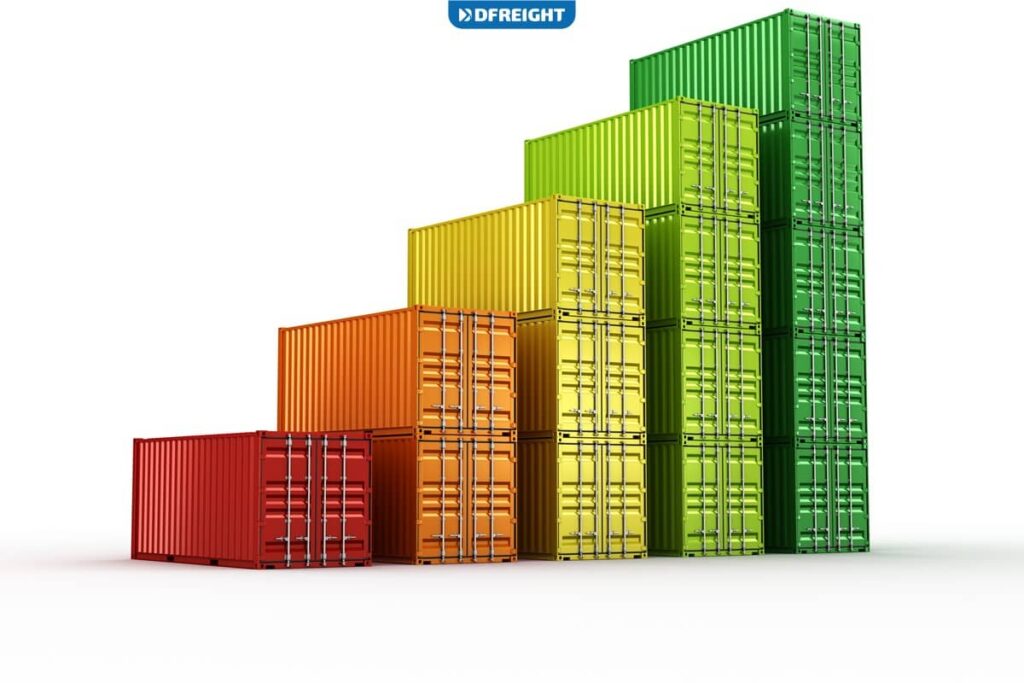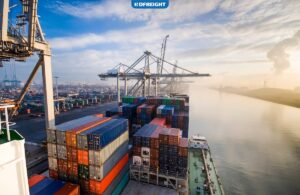Shipping containers have been around for over 50 years, and the International Organization for Standardization (ISO) spearheaded its standardization shortly thereafter. They are used to transport millions of tons of cargo every day to thousands of ports worldwide. Without shipping containers, the world supply chain would come to a halt, and the world economy would be highly affected. As a shipper, you must know what container best meets your shipping needs most affordably. To learn more about them, their types, and how to choose the right one, continue reading this post.
Table of Contents
What Are Shipping Containers?
Shipping containers are large, strong, rectangular boxes that are used to transport goods by ocean, land, and air. They are typically made of steel but can also be made of aluminum and are designed to be stackable and weatherproof. Shipping containers come in a variety of sizes, but the most common are 20 feet (6.1 meters) and 40 feet (12.2 meters) long.
Where Did Shipping Containers Come From?
In 1852, Malcom McLean was born in North Carolina. McLean was a truck driver who became interested in the efficiency of shipping cargo after he saw how much time was wasted loading and unloading cargo onto ships. In 1956, McLean bought a shipping company and began using containers to transport cargo. This method was much faster and more efficient than the traditional method of using cranes to load and unload cargo onto ships.
Since the introduction of shipping containers, the efficiency of transporting cargo has increased dramatically. Containers can be loaded and unloaded quickly and easily, and they can be stacked on top of each other, which saves a lot of space. Shipping containers have also made it possible to transport cargo by rail and road, which has further increased the efficiency of the shipping industry.
Key Benefits of Using Shipping Containers
- They are extremely strong and durable, able to withstand heavy weather and rough conditions.
- They are easy to transport and can be stacked on top of each other, meaning they take up less space.
- They are simple to modify and can be adapted to suit various storage needs
- They are sustainable, made from eco-friendly materials, and can be recycled when no longer needed.
- They are available in various sizes, meaning there is a perfect option for every project.
6 Main Types of Shipping Containers
There are many types of shipping containers out there, each with its specific purpose. The most common type of container is the ISO Standard container, which is used for the vast majority of intermodal freight transport. These containers are generally either 20 or 40 feet long and are 8 feet wide and 8.5 feet tall. They are made of steel and have either corrugated or smooth sides. There are also specialized containers, such as reefers (refrigerated containers), tank containers (for liquids), and flat-racks (for oversized cargo or oddly-shaped cargo). Here are the six main types of containers used for shipping various commodities.

Standard Containers
A standard shipping container is the most common type of container used for shipping goods by sea. They are typically made of steel and are available in various sizes, from 20 feet to 40 feet in length. Standard shipping containers are used for a variety of applications, including the transport of general cargo, automobiles, and construction materials.
High-Cube Containers
High-cube shipping containers are similar to standard shipping containers but are taller. They are typically used for shipping taller items, such as machinery or furniture. High cube shipping containers are available in a range of sizes, from 40 feet to 53 feet in length.
Refrigerated Containers
Refrigerated shipping containers, also known as reefers, are used to transport perishable goods that need to be kept cool or frozen. Reefers are typically made of steel and are available in various sizes, from 20 feet to 40 feet in length. Reefers are equipped with a refrigeration unit that maintains the desired temperature for the goods transported.
Flat-Rack Containers
Flat-rack shipping containers are used to transport oversized or oddly-shaped items that cannot be loaded into a standard shipping container. Flat racks are typically made of steel and are available in a range of sizes, from 20 feet to 40 feet in length. Flat racks can be equipped with walls, doors, or covers, depending on the shipment’s needs.
Open-Top Containers
Open-top shipping containers are a type of container with a roof that can be removed. This makes them ideal for carrying tall or bulky items that must be loaded from the top. They are also often used for carrying dangerous goods or hazardous materials, as the open top allows for ventilation. Open-top containers are available in various sizes and can be made from steel or aluminum.
Tank Containers
A Tank shipping container is a large metal container used to transport liquids and gases. They are often used to ship crude oil, chemicals, and other hazardous materials. Tank shipping containers are made of thick steel and are lined with an impermeable material, such as rubber or plastic. This prevents the contents from leaking and keeps the cargo from being contaminated. Tank shipping containers are typically much larger than other types of shipping containers and can hold up to 80,000 gallons of liquid. They are usually transported by train or truck.
How to Choose the Right Shipping Container?
There are a few things to consider when choosing the right shipping container for your needs. First, you need to decide what size container you need. Shipping containers come in a variety of sizes, from small 10-foot containers to large 40-foot containers. The size you need will depend on the amount of goods you need to ship.
Next, you need to decide what type of container you need. There are two main types of shipping containers: dry containers and reefers. Dry containers are used for general cargo, while reefers are used for perishable goods or temperature-sensitive products that need to be kept at a specific temperature.
Finally, you need to decide what kind of container you need. There are three main types of containers with different container shipping rates: new, used, and one-trip. New containers are the most expensive but are also the most durable. Used containers are a cheaper option but may not be as durable. One-trip containers are only used once and then sold, so they are the cheapest option but also the least durable. When choosing a shipping container, it is essential to consider all of these factors to ensure you choose the right container for your needs.

Let Us Choose the Right Container for Your Shipment
DFreight is a leading digital freight forwarding company in the UAE, offering various freight services by sea, air, and land. We can help you with all of your shipping needs, no matter where in the world you need to ship your goods. We are partnered with a wide range of shipping lines worldwide, so we can help you choose the most suitable and affordable option for your shipment. Contact us today to get started.
FAQs
What Are Shipping Containers?
Shipping containers are large, strong, rectangular boxes that are used to transport goods by ocean, land, and air.
Who invented the first shipping container?
Malcolm McLean, a truck driver from North Carolina, invented the first shipping container in 1956.
What are the main types of shipping containers?
The six main types of shipping containers include standard containers, high-cube containers, refrigerated containers, flat-rack containers, open-top containers, and tank containers.














